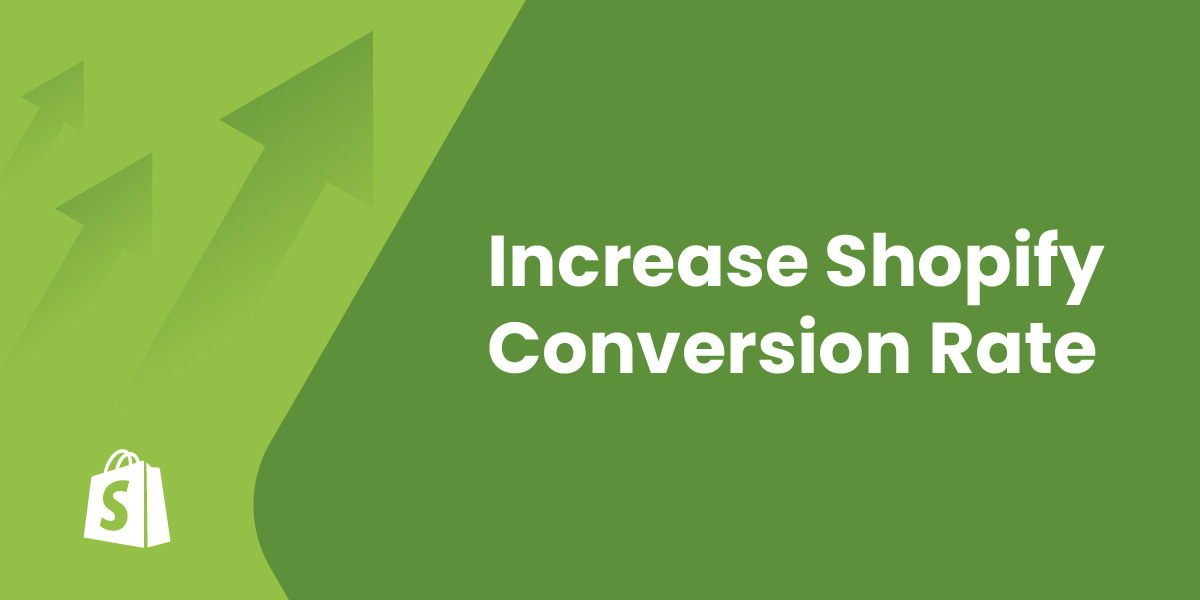Three Proven Tips to Increase Your Shopify Conversion Rate
In the current competitive e-commerce arena, increasing your Shopify store's conversion rate is critical for driving growth and profitability. Knowing how to optimize key aspects of your store can significantly boost conversions, making your business more successful and sustainable.
Understanding Shopify Conversion Rates
Before diving into the strategies that can increase your Shopify conversion rate, it's crucial to understand what conversion rate implies and its significance in e-commerce.
In the context of online retail, a conversion rate refers to the percentage of visitors to a website who complete a desired goal (a conversion) out of the total number of visitors. This desired goal could be any action that you want your visitors to take, such as making a purchase, signing up for a newsletter, downloading an app, or completing a form.
Conversion rates are a vital metric for any Shopify store because they quantify the effectiveness of your marketing and site design efforts. A high conversion rate implies that your store's design and marketing strategies are successful in persuading visitors to carry out the actions you want them to. This means that your store is not only attracting visitors but also converting them into customers or leads.
Furthermore, higher conversion rates mean more sales and revenue for your Shopify store, contributing positively to your bottom line. By focusing on improving your conversion rate, you can maximize the return on investment (ROI) for your marketing efforts and increase the profitability of your online business.
There are several factors that can influence your Shopify conversion rate. One of the most important factors is the user experience (UX) of your website. A well-designed and user-friendly website can make it easier for visitors to navigate, find products, and complete their desired actions. On the other hand, a poorly designed website with confusing navigation and a cluttered layout can frustrate visitors and lead to a high bounce rate, negatively impacting your conversion rate.
In addition to UX, the clarity and effectiveness of your marketing messages also play a crucial role in converting visitors into customers. Your product descriptions, call-to-action buttons, and overall messaging should be clear, compelling, and persuasive. By clearly communicating the value and benefits of your products or services, you can increase the likelihood of visitors taking the desired actions.
Another important factor to consider is trust and credibility. Online shoppers are often cautious and skeptical, especially when it comes to making purchases from unfamiliar websites. By establishing trust and credibility through customer reviews, testimonials, secure payment options, and clear privacy policies, you can alleviate any concerns and increase the conversion rate of your Shopify store.
Furthermore, optimizing your website for mobile devices is crucial for improving your conversion rate. With the increasing use of smartphones and tablets for online shopping, it's essential to ensure that your website is mobile-friendly and provides a seamless browsing and purchasing experience across different devices. A responsive design, fast loading times, and easy-to-use checkout process on mobile devices can significantly impact your conversion rate.
Understanding and improving your Shopify conversion rate is essential for the success of your online business. By focusing on factors such as user experience, effective messaging, trust and credibility, and mobile optimization, you can increase your conversion rate and drive more sales and revenue for your Shopify store.
Analyzing Your Current Conversion Rate
The first step towards improving your Shopify conversion rate is understanding your current performance. By calculating your conversion rate and identifying the areas that need improvement, you can formulate an effective strategy for incremental progress.
Conversion rate is a crucial metric that measures the percentage of visitors who take a desired action on your website, such as making a purchase or filling out a form. It provides valuable insights into the effectiveness of your marketing efforts and the overall user experience of your Shopify store.
Calculating your conversion rate is a straightforward process. To get started, you need to divide the number of conversions by the number of total visitors to your store, then multiply the result by 100. For example, if you had 50 conversions from 500 visitors, your conversion rate would be 10%.
How to Calculate Your Conversion Rate
To calculate your Shopify store's conversion rate, you need to follow these steps:
- Identify the number of conversions: This refers to the desired actions taken by visitors, such as completing a purchase, signing up for a newsletter, or downloading a resource.
- Determine the total number of visitors to your store: This includes both new and returning visitors who have interacted with your website.
- Divide the number of conversions by the total number of visitors.
- Multiply the result by 100 to get the conversion rate percentage.
By regularly monitoring your conversion rate, you can track the impact of any changes you make to your website and marketing strategies. This data-driven approach enables you to make informed decisions and optimize your conversion rate over time.
Identifying Areas for Improvement
Once you understand your conversion rate, the next step is to identify areas for improvement. This analysis involves a deep dive into various aspects of your Shopify store that may be influencing your conversion rate.
One area to consider is your website design. A visually appealing and user-friendly design can enhance the overall user experience, making it more likely for visitors to convert. Analyze the layout, color scheme, and navigation of your website to ensure they align with your target audience's preferences and expectations.
Another aspect to evaluate is your product descriptions. Compelling and informative product descriptions can help potential customers understand the value and benefits of your products, increasing the likelihood of a purchase. Ensure that your descriptions are clear, concise, and highlight the unique selling points of each product.
Additionally, pay attention to your calls-to-action (CTAs). These are the prompts that encourage visitors to take a specific action, such as "Buy Now" or "Sign Up Today." Optimizing your CTAs by making them visually prominent, compelling, and strategically placed can significantly impact your conversion rate.
Furthermore, it is essential to analyze user behavior on your website. Look for patterns that could be influencing your conversion rate, such as high bounce rates on specific pages or low engagement with certain elements. By identifying these patterns, you can delve deeper into the underlying causes and develop targeted strategies to address them.
Analyzing your current conversion rate is a crucial step towards improving your Shopify store's performance. By calculating your conversion rate and identifying areas for improvement, you can implement effective strategies to optimize your conversion rate and drive incremental progress in your business.
Improve Your Store's Design
A well-designed Shopify store can significantly enhance your conversion rate by improving user experience and increasing customer trust. When it comes to running an online store, the design of your website plays a crucial role in attracting and retaining customers. A visually appealing and user-friendly design can make a world of difference in how potential buyers perceive your brand and products.
Importance of a User-Friendly Design
User-friendly design is about making your website easy to navigate, visually appealing, and straightforward to use. It's like creating a seamless path for your customers to explore your offerings and make a purchase without any obstacles along the way.
Imagine visiting a website that is cluttered with a confusing layout, tiny product images, and a convoluted checkout process. Frustrating, right? Well, that's exactly what you want to avoid with your Shopify store. By focusing on a user-friendly design, you can ensure that your visitors have a pleasant experience, encouraging them to stay longer and explore what you have to offer.
A well-designed website can help your visitors find what they are looking for more quickly and easily, increasing the likelihood of them making a purchase. By organizing your products into logical categories and providing clear navigation menus, you can guide your customers effortlessly through your store, helping them discover the items they desire.
Best Practices for Shopify Store Design
Now that we understand the importance of a user-friendly design, let's dive into some best practices for your Shopify store.
First and foremost, make sure to use high-quality product images. Visuals play a crucial role in online shopping, as customers cannot physically touch or examine the products. By providing clear and enticing images, you can give potential buyers a better understanding of what they can expect, increasing their confidence in making a purchase.
Another essential aspect of your store's design is ensuring it is mobile-friendly. With the rise of smartphones and tablets, more and more people are using these devices to browse and shop online. If your store is not optimized for mobile devices, you risk alienating a significant portion of your potential customer base. Therefore, it is crucial to create a responsive design that adapts seamlessly to different screen sizes, providing a consistent and enjoyable experience for all users.
Consider creating a simplified checkout process. Lengthy and complicated checkout forms can be a major turn-off for customers, leading to cart abandonment. Streamlining your checkout process by only asking for essential information and providing multiple payment options can significantly improve your conversion rate and reduce friction in the buying process.
Lastly, organizing your products into easy-to-navigate categories is essential. This allows customers to quickly find the specific items they are interested in, rather than having to sift through a jumble of unrelated products. By implementing clear and logical categories, you can enhance the overall browsing experience and help customers find what they need with ease.
By following these best practices for your Shopify store design, you can create a visually appealing and user-friendly website that not only attracts potential customers but also encourages them to make a purchase. Remember, a well-designed store is a key ingredient in the recipe for e-commerce success.
Optimize Product Descriptions
Product descriptions play a vital role in influencing potential customers to make a purchase.
Writing Effective Product Descriptions
Effective product descriptions are persuasive and informative – they describe the features and benefits of the product, use a compelling tone of voice, and answer any questions the customer might have about the product.
Using SEO in Product Descriptions
Search engine optimization (SEO) is another important element of product descriptions. Using relevant keywords in your descriptions can help your products appear in search engine results, driving more traffic to your store and potentially increasing your conversion rate.
Implement a Strong Call-to-Action
A compelling Call-to-Action (CTA) can play a significant role in influencing your visitors to take action.
The Power of a Good CTA
A strong CTA guides your visitors towards conversion, such as making a purchase or signing up for a newsletter. The language used in your CTA can greatly impact its effectiveness, with action words and urgency often leading to higher conversion rates.
Examples of Effective CTAs
Examples of effective CTAs include “Buy Now,” “Add to Cart,” and “Subscribe Now.” Experiment with different CTAs to discover what works best for your audience.
Conclusion
By implementing these proven tips, you can significantly increase your Shopify store's conversion rate, leading to higher revenue and business growth. Remember, improving your conversion rate is a continuous process that requires regular testing and optimization.

 Drive More Visibility, Traffic, and Sales
Drive More Visibility, Traffic, and Sales
